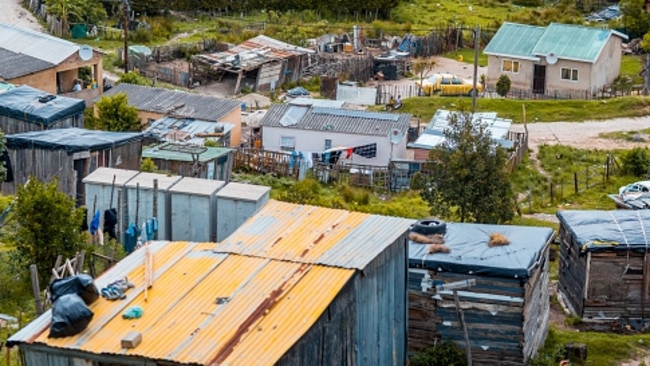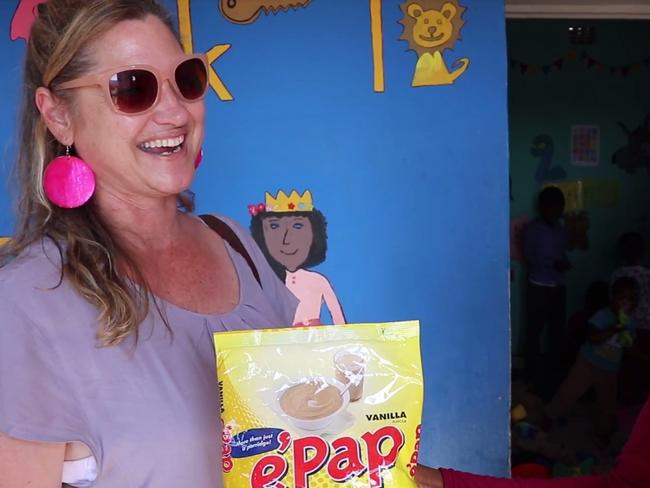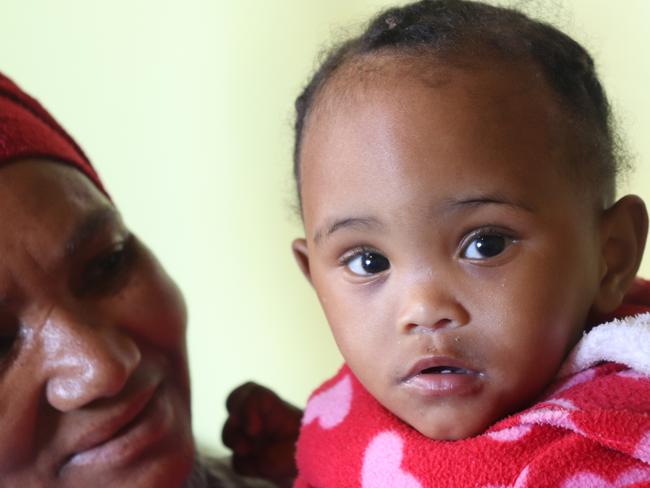Impact tourism: ‘Communities that don’t typically attract visitors’
IT MAY be home to one of the most spectacular coastlines in the world, but it is in now way representative of how most of its inhabitants live.
A GROUP of tourists gasps in awe on top of one of the world’s most breathtaking mountains before sipping champagne and soaking up the view.
The next day they venture to where most people dare not go: South Africa’s slums.
But they haven’t come for selfies or voyeurism. They’re ‘impact tourists’ who are fuelling one of the fastest-growing sectors in international adventure travel.
Impact tourism combines sightseeing with volunteer work in disadvantaged communities to give tourists the opportunity to travel and engage with locals to create positive change.
One global tour companies to have embraced the movement is Collette which operates volunteer programs through its own charity ‘Collette Cares’ helping children and communities through hunger and education initiatives in several countries around the world.
It launched its first South Africa impact tour in September after having worked with several local communities through its charity arm for a decade.
South Africa is a nation steeped in history, rich in natural beauty and minerals but poor in job opportunities, housing and health care. It’s a combination that has made it a popular destination for impact tourists who are among some 10 million international travellers who flock to ‘the motherland’ each year.
News.com.au joined Collette on its South Africa pilot tour to find out what all the fuss is about.
WHAT DOES AN IMPACT TOUR INVOLVE?
Collette tour guide Ian Pletzer welcomes a group of 26 mostly American tourists who will embark on a trip to multiple cities and towns across the Western Cape of South Africa over the next seven days.
Day one consists of a cable car up magnificent Table Mountain and hike on its summit which towers about the seaside city of Cape Town, the country’s legislative capital, in the Western Cape. The flat-topped mountain stands at 1085m tall and is often blanketed by a layer of clouds pouring off the top like an ethereal waterfall, referred to by locals as “the tablecloth”.
On a clear day, vibrant wildflowers colour the summit as native critters known as ‘rock badgers’ daringly scurry along the edges.
On the way back to the city we stop for a walking tour through the colourful town of Bo-Kaap.
The night is capped off with djembe drum lessons and performances, a prelude to a communal dinner at Cape Town’s Gold Restaurant where waitstaff wear traditional dress and serve African food.
But to get to the heart of the real South Africa we must leave the city. Beyond the veneer of Cape Town’s sparkling marina and just a few kilometres inland from one of the most spectacular coastlines in the world, are lives and landscapes so diverse that none of it makes immediate sense. “The V&A waterfront is the modern South Africa. But this is not representative of how most South Africans live,” local tour guide Ian tells news.com.au.
ALONG THE GARDEN ROUTE
The following day, we leave Cape Town by bus and head for Knysna, about 500km west along the southern coast of the Western Cape province.
The Garden Route — or Route 62 — has been described as one of the most scenic drives on the planet and it doesn’t disappoint. Sparkling coastal regions run parallel to bright canola fields, vineyards and lush green hills that soon give way to dusty, red desert plains and dry, rocky mountain ranges.
After about 10 hours on the road with a few stops in between, we eventually arrive at the recently fire-ravaged seaside town of Knysna, population about 70,000.
We’ve come to meet with The Knysna Education Trust (KET), which is one of Collette Cares’ partners. A representative from the Trust explains how KET helps disadvantaged communities to establish preschools, train teachers and ensure young children are given the best start in life.
But it’s not the Knysna waterfront or surrounding suburbs where million dollar boats are docked that the organisation’s help is needed most.
THE TOWN ON TOP OF THE HILL
On top of a hill that overlooks the city is a shanty town so vast it can be seen from anywhere in Knysna. It’s made up of thousands of shacks — homes, businesses and preschools — that are built from scraps and mostly operate without electricity or running water.

Many of the families are too poor to afford day care or preschool for their children. Mothers often work with their babies attached to their backs. Other children ��� some too young to properly speak — roam the streets alone. KET worker Veranique (Vee) de La Fontaine has made it her life’s work to help.
“If you can imagine a scale ... some people start life at plus 100, others start at zero, and others start at minus 100 and spend their entire lives just trying to get to a baseline of zero,” she says.
“We want to help them at least start out with a baseline that’s not in negative.”
KET has helped establish and sustain several preschools for children under seven, who were “left on their own while their parents are at work”, in the township. It relies largely on donations and grants to achieve its goals but it's the sheer determination, compassion and tireless work of its staff and community members that really brings it to life.
“A good teacher can teach under a tree, so we focus on the learning first, and the structure comes later,” Vee explains.

The tour group is escorted to the hilltop township to visit the preschools KET is affiliated with. Life is tough in the informal settlement but that hasn’t killed the spirits of those who live there. Tiny children with smiles as wide as they can stretch shriek with delight and run to meet us at the gates.
They don’t know who any of us are yet their excitement is palpable. Visitors don’t often come here. Most of the students have loving families but money is so tight the parents are almost always working, Vee tells us. Some of their parents have alcohol and drug problems, afforded with welfare payments. The preschoolers playfully mob the adults, craving affection and attention as our group walks inside.
It’s here the volunteer work begins. Volunteers are invited to spend time over the next two days helping with educational programs including reading activities, playing games, crafts, preparing meals and more.
“What you’re donating is your time,” Ian tells volunteers.
MAKING A DIFFERENCE
We approach Judas Square, a suburb within the township generally closed to the public, where residents with dreadlocks past their knees wander the graffitied streets.
“Most of the residents smoke marijuana,” Vee says.
“They’re very happy.”
Men smile as they blow smoke in front of a row of brightly painted shacks next to another preschool buzzing with young children. Judas Square preschool Principal Nancy Melville says it charges parents who can afford it “low fees” to send their children but most of the facility’s funding comes from KET and overseas sponsors who also help provide food.
“It’s very important for kids to come to preschools,” Ms Melville tells news.com.au.
“It prepares them for school and makes them far less likely to ever dropout.”
We visit another preschool afterwards where we have lunch among the ancient milkwood trees on the grounds then paint murals and fences as part of the volunteer program.

READ: South Africa’s illegal backstreet abortions
READ: Robben Island prison: ‘Five months in solitary’
FROM SLUMS TO COCKTAILS
In a dramatic shift of gears, the tour group is transported back to the base of the hill where a large boat awaits to take us on a sunset cruise across Knysna Heads. Guests drink local beers, wine and cocktails while taking in the atmosphere.
The entire time we can see the Knysna township on top of the hill. The tin roofs glisten under the African sun. It’s an extreme contrast that only deepens the following day when we arrive at a waterfront restaurant for champagne, oysters and a four course lunch.
It’s followed by a return to the Knysna township to present locals with hippo rollers — a device which makes carrying freshwater easier and more efficient — on behalf of the Collette Foundation. The hippo rollers ease the burden on families and children who spend hours each day collecting freshwater in buckets on their heads and frees up their time for school.
After another night’s rest we soon depart, bound for the desert plains of Oudtshoorn, the ostrich capital of South Africa. Once there, a safari buggy takes us on a guided tour of an ostrich farm before we sit down for a catered lunch — which includes the local delicacy of ostrich — on site.
‘YOU CAN’T TEACH MALNOURISHED CHILDREN’
Our final stop is majestic Stellenbosch, in South African wine country. Wilderbeast, zebras and springbok can be seen from the road grazing at the foot of mountains and in game breeding farms. Immaculate wine estates roll into each other until separated by overcrowded slums full of tin shacks, abandoned vans and residents standing outside under wet skies.
We reach a modest building at the end of a winding dirt road in the middle of a wine farm. The preschool — which includes a baby room for the 0-2 age group — is one of several in the area supported by the Pebbles Project.
The organisation provides literacy, nutritional and health programs to children whose parents live and work on farms in nearby slums. It includes mobile vans with desks, computers, toys, books, DVD libraries and more.
Pebbles Project fundraising and PR manager Charmaine Gola tells news.com.au the families in the region are “quite far away from general schools and access to health care and other services”.
“So we come in to make sure those facilities are available on the different farms where the children are based,” she says.


The organisation also provides a free shuttle service to and from clinics and supplement lessons with health and nutrition programs for all children at the centres.
“They get two meals and two snacks daily,” Charmaine says. “You can’t teach malnourished or hungry children.”
We are invited inside to meet the children who are in fancy dress for the occasion. They could warm even the steeliest of hearts. After lots of hugs, smiles and playtime with the children, volunteers soon roll up their sleeves and help with everything from food preparation to nursing the babies. Before we know it, it’s time to leave.
The day continues with a walking tour through the charming town of Stellenbosch, which boasts both narrow and wide winding cobblestone roads and grand, white buildings. It ends with a wine tasting and regional delicacies at the Spier wine farm where we spend the last two nights of the trip.
THE VERDICT
The tour ends in bustling Cape Town where guests try to reconcile the extreme contrasts they have been exposed to over the past seven days.
Champions of the venture claim impact tourism is revolutionising travel by creating mutually beneficial relationships and experiences for locals and tourists.
Collette Australia general manager Alison Mead says she has “seen the difference” that the tours, which enable guests to contribute to the development of communities, have made.
But impact tourism has its critics, with some arguing that volunteer projects merely serve the egos of tourists and encourage voyeurism.
The true impact of the experience, however, is best measured in person. The joy the interactions bring to the children in communities that don’t typically attract visitors is just as apparent among the volunteers who clearly get a strong sense of satisfaction out of helping those in need. There is much to be gained on both sides of this exchange but ultimately it’s the human spirit which benefits most. And in a world where indulgence, selfishness, suffering and disadvantage are ever present — that can only be a good thing.
— Journalist Megan Palin was a guest in South Africa of Collette. The company will run its next impact tour in South Africa on November 9, 2018. For more information on the tours it offers, visit here.




